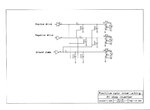Warpspeed
Advanced Member level 5

- Joined
- May 23, 2015
- Messages
- 2,366
- Helped
- 773
- Reputation
- 1,548
- Reaction score
- 789
- Trophy points
- 1,393
- Location
- Melbourne, Australia
- Activity points
- 20,319
My system is still under construction, but the basic idea is to rectify the incoming 240v three phase supply with phase controlled SCRs to generate a rock solid +/- 300v dc supply bus, with plenty of holdup capacitance.Is your +/- 300 volts derived directly from batteries or solar panels, or is it regulated?
This inverter will sit across that dc bus to generate 240v nominal to run my house.
Now the unusual part of all this, is that I can then feed some dc power from batteries or solar into that +/- 300v dc bus, to power all my small constant loads.
When my dc/dc converter jacks up the +/-300v bus to perhaps +/-310 volts, voltage feedback in the SCR rectifier throttles down the SCRs totally, and all my power comes from solar/batteries.
So something like a few watts to a few hundred watts of 240v load will be then totally solar powered.
If someone turns on a huge sudden load, the solar system would be easily overpowered, and the dc bus voltage will fall from 310v to 300v, but not too quickly if there is enough holdup capacitance.
Voltage feedback in the SCR rectifier will swing into action within milliseconds,and take up the load.
Something like my refrigerator has a 140 watt running load, easily supplied by solar, but a 3.9Kw starting current. Its about 1KJ for one second inrush.
This way, I could run just the refrigerator off one solar panel, and use grid power just for sourcing the startup inrush.
I can get 3600 fridge starts from the grid for 1KWH cost, and otherwise run my refrigerator for free.
So far I have the 9KW three phase SCR rectifier module complete.
The 1.5KW prototype inverter is about 99% there, a much bigger one will come later I did make a second set of boards to build another.
Next comes a 1 to 1.5Kw dc/dc converter. 30V nominal in, +/- 310v out.
That is going to be be of a very simple and unusual topolgy that is going to surprise a few people.
Sunny Skyguy,
No snubbers needed. But it does need a lot of capacitance on the dc supply bus.
The reason being that when one of the inverters "subtracts" from the ac output voltage, power is recirculated back into the dc bus. The bus bounces around a fair bit unless it is well tied down with plenty of microfarads.
Alertlinks,
This type of inverter is quite happy with the type inrush loads caused by refrigerators and airconditioners. Transformers can handle huge short overloads quite well, and IGBT modules are available rated at hundreds of amps.
If you have the raw dc power to feed it from, the inverter itself is going to cope easily.


